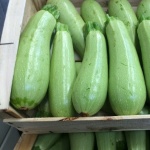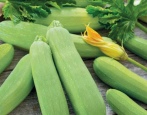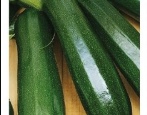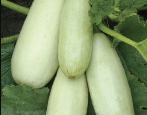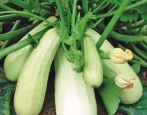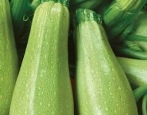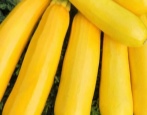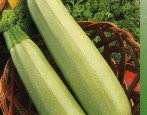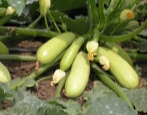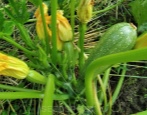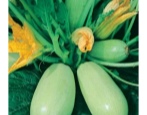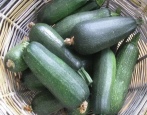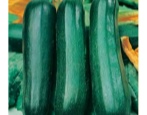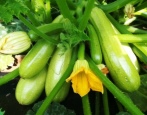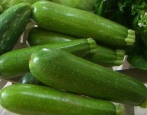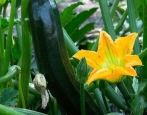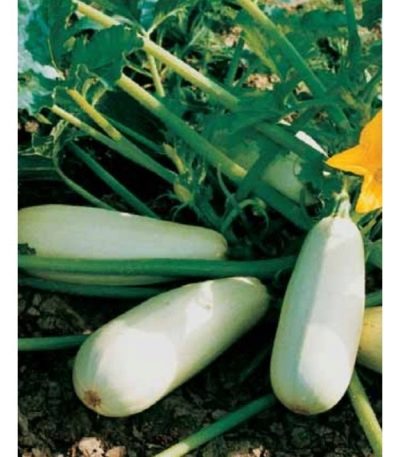
- Authors: Yurina O.V., Ermolenko I.V.
- Year of approval: 1987
- Ripening terms: early maturing
- The period from germination to harvest: 38-40 days
- Description of the plant: weakly branching
- Leaves: dark green, delicate
- Fruit shape: cylindrical, with a slight slope to the peduncle
- Fruit color: light green in technical ripeness, light yellow in biological ripeness
- Color of the pulp: light yellow
- Pulp (consistency): dense, delicate
Zucchini are very healthy and tasty vegetables, so many gardeners are trying to grow at least a little in their summer cottage. The early maturing variety Anchor, bred by domestic scientists, is one of the popular and reliable varieties.
Breeding history
Zucchini Anchor was bred by scientists of the Federal Research Center of Vegetable Growing in 1983. The authors of the vegetable culture are OV Yurina and IV Ermolenko. After several variety trials, the zucchini was added to the State Register of approved for use, it happened in 1987. You can grow a vegetable in garden beds, as well as on farm fields. The culture is zoned into eight regions: from Volgo-Vyatka to Central. In addition, the vegetable is massively grown on the territory of Moldova and Ukraine.
Description of the variety
The anchor is a compact bush plant. The bush is characterized by weak branching of branches, rare foliage with dark green foliage and shortened internodes. A distinctive feature of the variety is the pronounced venation of the leaves. The plant has no tendency to thicken. During the flowering period, large bright yellow flowers appear on the bushes.
Characteristics of the appearance of plants and fruits
This variety represents a class of large-fruited varieties. Fruits ripen smooth and neat, therefore they are massively grown for commercial purposes. The average weight of a vegetable is 600-900 grams with a length of up to 30-40 cm. The shape of the fruit resembles a cylinder with a weak escape at the base. Sometimes the fruit takes the shape of an irregular cylinder. At the stage of technical ripeness, zucchini have a pale greenish color, and a ripe vegetable is evenly covered with a light yellow cover. The skin of the fruit is thin and fragile, with a smooth surface.
Collected copies are transported over short distances, and can also be stored under appropriate conditions for about a month. For long-term keeping quality, neatly cut specimens are selected.
Purpose and taste
The anchor is famous for its great taste. The yellowish flesh is characterized by a firm, fleshy and uniform structure. The seeds inside the vegetable are small and not rigid. The peel is fragile, therefore it does not impart hardness and unpleasant taste to the vegetable. Zucchini has a balanced, pleasant taste, complemented by juiciness and tenderness.
Ripe vegetables have a wide range of uses in cooking: they are fried, pickled, stuffed, frozen, canned, added to various hot dishes, and also processed into caviar and salads. The youngest specimens can be cooked without peeling.
Ripening terms
Anchor - early ripening marrow. The growing season lasts less than 40 days. Fruiting lasts for 3 months: from July to September. To prevent vegetables from overripe, they need to be harvested every 2-3 days. Experienced vegetable growers recommend collecting specimens up to 20-22 cm long: they are considered to be the most delicious.
Yield
This variety is quite fruitful if properly cared for. On average, up to 10 kg of even specimens can be collected from 1 m2 of plantings.The maximum yield is recorded at around 12 kg / m2.
Growing and care
Zucchini is cultivated by seedling and seed methods. The best time for planting is the end of May - the first week of June. At this time, the temperature regime is already stabilizing, spring frosts will be left behind, so the vegetable crop will grow and develop comfortably. Planting is carried out according to the 70x70 cm scheme. Sometimes the vegetable is planted more compactly, using the 60x60 cm scheme. Legumes, root vegetables, nightshades or cabbage will be good predecessors for a vegetable.
Vegetable farming consists of basic procedures: regular watering (interval - 5-7 days), fertilizing three times per season, weeding and loosening the soil, mulching, prevention of viruses and insect pests. To prevent the fruits from rotting, in contact with the ground, it is necessary to lay a protective layer of non-woven material or pine needles under the bushes.
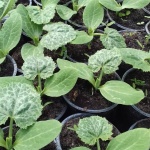

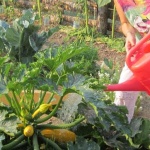
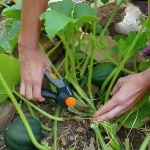
Soil requirements
Zucchini prefers light, nutritious and breathable soils with neutral or low acidity. Loamy and sandy loamy soils that allow moisture and air to pass through are best suited for growing Anchor squash.
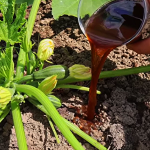
Required climatic conditions
Anchor is a light-loving and stress-resistant culture, therefore it does not react to temperature fluctuations, cold. The site for planting is chosen to be flat, sunny, protected from drafts and cold winds.
Disease and pest resistance
The culture has an average immunity, therefore, during the cultivation process, one should not forget about preventive measures aimed at preventing diseases. Most often, zucchini are exposed to powdery mildew and downy mildew, as well as apical, root, white and gray rot. When diseases appear, fungicides are used to spray the bushes.
